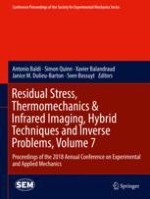2019 | Book
Residual Stress, Thermomechanics & Infrared Imaging, Hybrid Techniques and Inverse Problems, Volume 7
Proceedings of the 2018 Annual Conference on Experimental and Applied Mechanics
Editors: Dr. Antonio Baldi, Dr. Simon Quinn, Dr. Xavier Balandraud, Janice M. Dulieu-Barton, Sven Bossuyt
Publisher: Springer International Publishing
Book Series : Conference Proceedings of the Society for Experimental Mechanics Series
